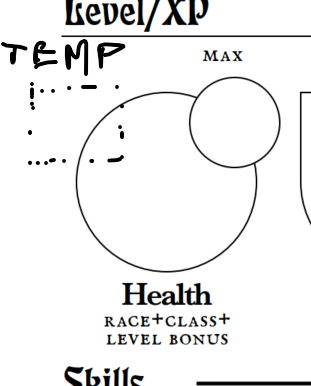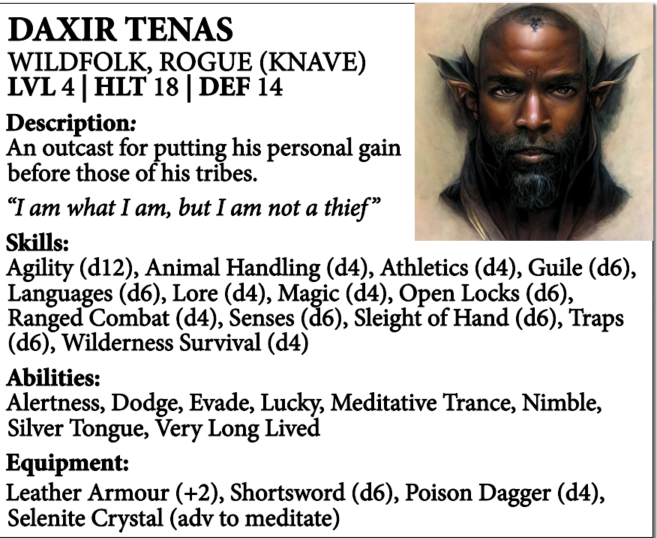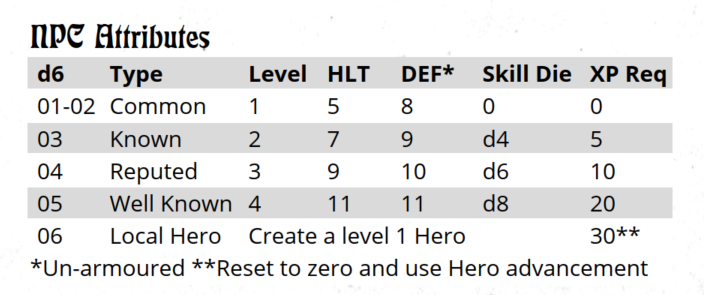I imagine allowing for some Wilderness Survival rolls to forage and hunt can also help conserve supplies.
Greymark
Recent community posts
(P) Combat Tactician; any successful melee attack is treated as a critical success.
Just checking that I understand this mechanic. Someone who takes this permanently gets a critical success for any successful melee attack. And critical success means a more positive outcome.
Can you elaborate how this plays out in a game?
For magic users, health loss temporarily cannot be healed except by rest. Obviously, intra-day/intra-battle healing is a regular occurrence. Should the character record sheet not track this? I am curious how players have been managing this during play? Notation off to the side of health? The temp health thing for magic users is not common (broadly, I am sure there are systems out there) so it may not be intuitive to a new player. I think the character sheet should help reinforce.
What about something like:

or

I am wondering if I am missing a key concept ...
Heroes have skills which improve as one levels. Monsters have a single skill die used for checks.
According to the NPC chart, NPCs also have a single skill die. My assumption was that it works similar to Monsters. But then I came across the NPC Grun who has disadvantage on melee, athletics, and agility due to a bum leg. Which made me start thinking about the single skill die. With little experience Grun can become a level 4 NPC which means he has a Skill Die of d8 in every skill? If we look at our Hero Daxir at level 4 (which requires 120 vs 20 XP) while he has a few skills above a d8 mostly he is unskilled or less skilled. The NPC skill die and/or XP seems unbalanced.
If our friend Grun does well and becomes a Level 1 Hero, is he not going to lose skill in almost everything?
As I initially stated, I feel like I am missing a critical nuance and my conclusion is faulty.
I would appreciate any clarification.




I think my confusion or questioning here is the presentation of the information. Once you explained it, I have no problem following. Let me elaborate to what I refer using Referees Guide:
Under Combat you may take one of a list of Combat Actions. A subset of this list includes an Attack, a Combat Manoeuvre (these British spellings are killing me ... now I know how you must feel reading American English lol) or Use a Spell ability. In the same column you define Critical Success or Failure as:
Critical Success or Failure: On a critical success, a combat manoeuvre (i.e. stun, disarm, grapple) is automatically performed. On a critical failure, the weapon is damaged.
The problem I have with this layout is that there are several things in this column that could result in a critical roll.
In the right column you define/redefine Magic's definition of Critical Success or Failure. Now no one is going to confuse hitting with a sword and spell casting but if you are quickly looking up the impact of a crtical roll in combat you could miss this. For me, the layout is a bit of logical disonance.
Let me further explain because the above is nitpicky.
Combat manoeuvre includes Grapple which unlike the others provides an example opposed roll. There is a chance of critical roll during a combat manoeuvre and that is where I went down some wrong path thinking the verbiage about critical success or failure was related to the Combat Manoeuvre roll.
This is an unnecessarily long description of my mistake to propose a clarification and based on Nameless Designers response above a further clarification ... something like:
Critical Attack Success or Failure: On a critical success, a combat manoeuvre (i.e. stun, disarm, grapple) is automatically performed as appropriate for the situation. On a critical failure, the weapon is damaged.
Using a ranged weapon, you could argue something like Disarm as the arrow hits the opponent's hand and they drop the weapon. You will have to be clever to argue Grapple 40 feet away (I would never say 'never' to the internet as we know someone would prove me wrong).
If you really wanted to be consistent you could change magic critical success language to: Critical Magic Success or Failure
@NamelessDesigner
Would you be able to offer a brief understanding of the turn mechanic used for Press & Block? For example, Block says "disadvantage on attacks made and received until next turn". So, if I use my turn to block an opponent the Opponent has disadvantage on attacks they make till my next turn, and I have disadvantage on attacks received?
Similarly, Press, if I use my turn to press an opponent then they have advantage on attacks they make but I have advantage on attacks received?
So, timing and initiative order is important here I assume.
Do I have this right?
If anyone cares to share their opinion, I would be interested in which skill checks people use for the following:
Disarm Loses weapon; must use another
Grapple Restrain opposed strength/agility to free
Push/Pull Move victim a few feet in a direction
Stun/Trip Target acts at disadvantage next turn
Target Damage weapon/armour
Feint Advantage on your next attack
Parry Disadvantage on their next attack
Dominate Force morale check
Currently I am in the process of converting your system (with a focus on LoM - which is still a significant amount of data) into a relational dataset for my game so a lot of this falls out through that process (I also happen to be a decent proofreader so I may be noticing details that others don't). My recommendation is to start updating the pdf's but keep a log of the last update date per document. I will keep adding to my main threads. If you check them by date periodically you will know what's new. And when you're comfortable you have enough then issue an updated version. Honestly, I have held off posting everything I noticed, focusing on the most significant items as I was worried you would find the questions/info annoying. I will go all in. That said, I would give it a few weeks. I certainly won't get to everything but I do have the luxury of deciding what to focus on so I will make this aspect a priority. If necessary, you can PM on the reddit account, I sent you a PM with my username there.
I just finished the Ant Queen. Note that in LoM you indicate her size is 'Huge' but if I am not mistaken in most references, such as the tables in the Monster Compendium you don't have a 'Huge' category. You go from 'Large' to 'Colossal'. For example:
Monster Harvest Size Table
Size Number of Parts Harvested
Tiny 0.5
Small 1
Medium 1
Large 2
Colossal 4
Personally, and maybe this was your intent, I think you should have Huge between Large and Colossal. There is room there I believe. Paizo, for example, has Huge and Gargantuan in between Large and Colossal. It seems off to me that if an Ogre's category is Large that there is nothing in between an Ogre and all other bigger creatures. Of course, just my two cents. I will plan to add at least Huge to my game (assuming it proves to be a good fit as I work through other monsters). Intuitively, I think it should.
When comparing the Lair with the Monster Compendium most of the monsters are conceptually the same. Bat Swarm, however, is a bit unaligned. Health and Defense are reversed for example. Was this modification on purpose to adjust for the scenario or simply a clerical error? If error, which is your intended version?
pg. 56
The following spell is titled 'Animal' but refers to 'plant'. The word ask is misspelled "act".
Speak with Animals (Range Medium | Affects 1 question | Time Encounter)
Caster speaks with a plant and can act 1 key question. Magic check 10 to succeed
Similar spell/issue listed under both Shadow and Nature spells. Which does beg the question, "Speak with Animals" under shadow magic? Not intuitive to me. Maybe "Speak with Shadows"? ...well, if you can talk to plants :)
Are the following intended to be permanent?
Life drain seems like it would have its "flavor" or narrative uses occasionally. However, if intended to be permanent, Absorb seems very powerful, possibly overpowered? For example, losing Dark Vision or Great Cleave running into a 3rd level caster in some random encounter would be potentially devastating to that character long term. Or am I misunderstanding?
Absorb (Affects 1 | Size Medium | Level 3)
Drain an ability of an opponent through touch on a successful Magic vs. will check
Life Drain (Affects 1 | Size Medium | Level 3)
Touch a victim to age them 5 years (or equivalent) and add years to the casters. Magic vs fortitude to succeed
Most seem straight forward but two are causing me pause. Can you offer any insight into your thinking:
Selenite Crystal, adv. Meditation, three uses - Advantage on meditation ... What game mechanic does meditation impact?
Elven Leven Bread, last 4 days ... what is lasting 4 days? ... the bread lasts 4 days (seems underwhelming and costly) or you are satiated for 4 days?
Thanks
'During an encounter players can move one range band per turn.'
Are range bands abstract? Or are range bands 30' per band?For example, if I am "Far" from an enemy and decide to use my action to move two bands do I move 60' closer or do I move from 240' (Far) to Medium (60') (essentially moving 180' in that turn?). Then in my next turn (assuming the enemy did not move) I repeat myself and this time move two bands from Medium to Close (essentially moving 60' in that turn).
I am trying to understand the rationale for the 'bands'. Your maps use grids, so I assume you do use some sort of grid-based combat when playing? I have seen bands used in more of a theater of the mind and just trying to reconcile.
Maybe I missed the point or am over thinking (would not be first time on either account)
Thanks
Table:
Close, melee (5ft)
Short (30ft)
Medium (60ft)
Long (120ft)
Far (240ft)
Distant (>240ft)
Just to explain further, I am a 'hobby coder' and am intrigued by HoA as a possible rule set for a basic turn-based RPG game. Similarly, when creating an early alpha, it would be useful to have a pre-established adventure to follow so as not to have to worry about that aspect of design while coding and testing systems. Many table-top RPG designers may freely release mechanics, few release settings and original IP.
Do you have a Patreon or Ko-Fi etc.?
Lastly, your artwork is nicer than many paid products. Quite surprising for a free product.
Thanks for all your efforts and generosity.
Two questions .... I understand that the Core Rules are released under CC-by-4. I don't see a license reference for Lair of the Mutant? What is your intended license for your adventures like this or Lair? For third party releases I see most (all .... not sure) with the "Compatible with Heroes of Adventure". Does that imply compliance with CC-by-4? (Ironically, I would have had these questions before the WoTC debacle with OGL but now I guess I am topical.)


